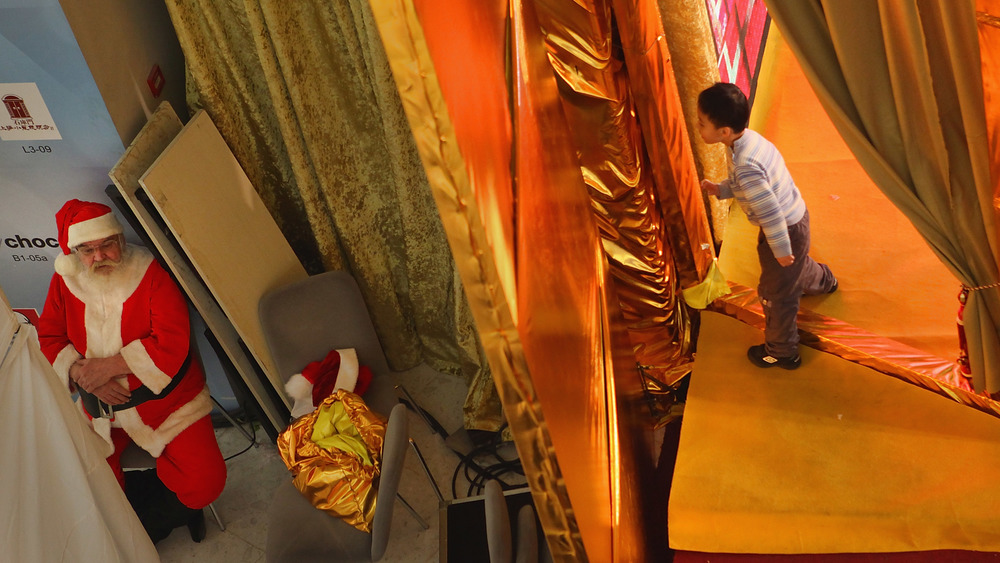The Origin Of Mall Santas Explained
Ever wonder why Santa Claus is called Saint Nick? According to History, the jolly old elf's origins go back centuries to a magnanimous bishop named Nicholas, later recognized as a saint. Born toward the end of the third century and ministering in what is now the country of Turkey, St. Nicholas was known for his selflessness. He was said to have given away his inherited wealth and walked the countryside helping those in need. His popularity spread through Europe, and his deeds led him to become known as the patron saint of children and sailors. The Dutch call him Sint Nikolaas, the shortened form of which is Sinter Klaas, and from there we got Santa Claus.
Little did old Saint Nick know just how his legacy would be revamped 1600 years after his time on this earth. He would go on to be named the patron saint of New York by writer Washington Irving and be turned into a Coca Cola-chugging, plaything-peddling icon of free market capitalism by the end of the 20th century. At least a dozen movies each year would task him with saving Christmas, in addition to the plethora of other duties he has at that time. And thousands of old men would impersonate our altered vision of what he looked like and sit in shopping malls to let countless children sit in their laps to ask if they're real. That last one is a Christmas staple these days, but exactly how did it get its start?
Department stores began using Santa to advertise in the early 19th century
As History notes, the concept of giving gifts became an integral part of Christmas during the holiday's popularization in the early 19th century. The jolly old guy's image began to be used in store advertising around 1820. By the 1840s, newspapers were printing separate holiday sections in which it was common to find representations of the newly re-imagined image of Santa Claus, the plump, white-bearded, and red-velveted one we all know and love (and believe in, of course) today. In 1841, a store in Philadelphia put a life-sized Santa statue on display, drawing thousands of children and their shopper parents to have a look at cheery old Kris Kringle. The trend quickly caught on, and soon stores across the country had their own versions of Santa come Christmastime.
In the spirit of the original Saint Nick, one of the first organizations to dress real people up as Santa Claus wasn't a for-profit business, but a charity. The Salvation Army began its now standard practice of soliciting change with bell-ringing Santas in the 1890s. The organization decked out unemployed men in bright red Santa outfits to raise funds for the needy, and the Salvation Army Santas are now a staple outside of American department stores in December. It was during this last decade of the 19th century that the ancestor of the shopping mall Santa came into being as well.
James Edgar invents the shopping mall Santa
According to New England Today, the first-ever department store Santa Claus appeared in Brockton, Massachusetts, in 1890. That year, a local store owner named James Edgar, whom everyone knew as "Colonel Jim," had a special suit tailored, and Santa showed up in his store. Kids went absolutely bonkers for the Santa, arriving from other cities in the state, and even from New York City, just to get a chance to sit in his lap. "My parents had taken me over to [Edgar's] store on Main Street," said one man who had seen the country's first shopping mall Santa as a boy. "I remember walking down an aisle, and all of a sudden, right in front of me, I saw Santa Claus. I couldn't believe my eyes. And then Santa came up and started talking to me. It was a dream come true."
Old Colonel Jim would end up becoming a local legend himself. The city of Brockton had once bustled as a famous shoe-making town, but the boom had turned to bust by the 1920s, and schoolchildren were missing school by the hundreds due to a lack of proper footwear. But the then-president of Edgar's Department Store, inspired by Colonel Jim's legacy, bought a shoe-repairing machine and hired cobblers to get the town's schoolchildren shod and back in class. Edgar's idea would also end up inspiring the classic Christmas movie Miracle on 34th Street (which was weirdly released in the summer, btw).


